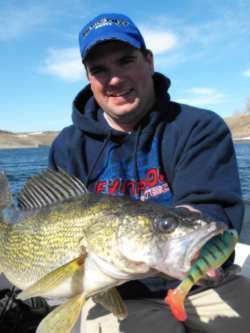Factors like water temperature and wind
seem increasingly important during spring. Often, the
most important piece of equipment is a temperature gauge
as activity often revolves around water temperature. A
temperature gauge also enables an angler to gauge the
influence of wind. Water temperature is relative in the
sense that there is no magic water temperature to find.
Rather an observation of where warmer pools of water are
located within a system.
Some locations just heat up better during
the spring and this difference in temperature often seems
to hold and attract fish. Many of the most productive
spots we find are bays within bays within bays…
small protected coves that are shallow and protected from
the fluctuations of the main basins. These protected pockets
will tend to warm up regardless of wind direction. Dark
bottoms tend to warm up even more and some of these protected
spots might only be five or six feet deep but these shallow
spots can and will hold a lot of walleyes.
A general rule of thumb is that the fishing
typically gets better in these locations during stable
weather. As long as the water temperature continues to
rise, these spots get more consistent to a point. Also
early in the year, afternoons and early evenings are sometimes
better as the water temperature jumps a few degrees during
the day. Typically, a falling temperature often slows
the bite. Triggers that might cool the water include changes
in wind direction where cooler water gets pushed into
the location from a cooler part of the lake, cold fronts
or cloud cover. The fishing can still be good but anglers
typically have to make some adjustments.
When the water temperature is stable or
rising, pitching crank baits or swim baits is extremely
effective. Both crank baits and swim baits allow anglers
to cover some water looking for the active fish. “Go
to” lures that we have caught a lot of walleyes
on across Minnesota and the Dakotas include the Salmo
Hornet and the Northland Slurpee Swim Shad. I like to
switch back and forth between the plastic swim bait and
the crank bait. Often starting with the crank bait as
the lure can be worked faster but we can often pick up
a few more fish with the swim bait as it touches different
parts of the water column and can be worked slightly slower
and different to trigger a few extra fish.

Legendary walleye angler, Jason Mitchell believes
that swim baits like the Northland Slurpee Swim
Shad are very effective early in the year |
From our experiences, crashing water
temperatures usually require a change in tactics.
The best is to move or avoid the dropping temp. Find
a pocket of water somewhere that was spared. If that
is not possible, a few changes are usually required
on the presentation. Lures can still be effective,
especially for finding fish but longer casts often
work better as turned off fish often follow the lure
longer before hitting. Live bait in combination with
sit and wait presentations can sometimes shine. Live
bait rigs or slip bobbers for example will still trigger
fish. Camping out on the sweet spots and waiting for
fish to move through can be a good strategy. When
things do get tough, go where you know there are fish
and work it long and hard. We often anchor up on the
best locations. |
Wind can also play a significant role in
walleye location but the reasons aren’t so simple.
The old cliché about following the windy shoreline
is only right about half the time… so there are
no hard rules. Let me explain. If wind is pushing warm
water into an area and there are already fish present,
wind will often turn the spot on, turnkey. Wind can also
muddy up the water, crash the water temperature and basically
ruin a good bite so we sometimes find the fish out of
the wind, focusing on the calm side of the lake. Often
as well, we might be more successful fishing “yesterday’s
wind” as a hard blow from a certain direction from
a few days previous might be the ticket after the fact.
Sometimes wind doesn’t make a spot good that day…
but it can turn the spot on a few days down the road.
Often as well, we might not find walleyes right up in
the chop of a real hard wind. A good starting point for
shallow fish seems to be “double the height of the
wave.” In two foot waves, try four feet of water.
This general rule of thumb seems to work really well for
us early in the season. In other words, we seldom find
walleyes in one or two feet of water if four foot waves
are crashing on shore. The only exception I have ever
seen is big fish.
Catching walleyes on many natural lakes
early in the season often comes down to small subtle factors
and variables. More often than not, location usually boils
down to the relationship between wind and water temperature.
|



